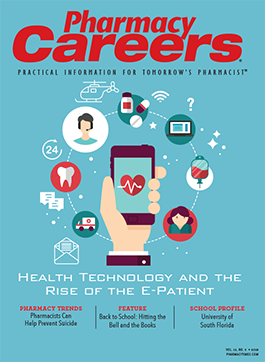Health Technology and the Rise of the E-Patient
Technology has become an essential part of health care.
Technology has become an essential part of health care. According to a 2015 market health intelligence report, an estimated 78 million consumers worldwide will be using health-based technologies by the year 2020.1 With more mobile health applications and easier access to personal health records, patients are able to assess their health biometrics more readily than ever before. The emergence of such technologies has given rise to the “e-patient,” establishing a new paradigm in which the responsibility of driving interaction has shifted from providers to patients.
Technological systems and software have been in use within certain practice settings such as retail pharmacy for decades, proving instrumental in helping pharmacists with dispensing, authorization, and verification, though they had little interface with patients. In contrast, the recent technological wave offers virtual medication counseling and management to patients but, in doing so, bypass an essential intermediary: the pharmacist. Pharmacy is multifunctional, but medication management has remained 1 of the most fundamental functions of pharmacists; as technology advances and more sophisticated programs and apps hit the market, it raises an important question of how the profession will be affected by health care digitalization.
So where do pharmacists fit in this new construct? As health care evolves and digitalization makes its global impact, pharmacists need to adapt, as well. Recent research has shown that electronic health applications and software provide real-time data recordings that pharmacists can use to help guide treatment for chronic conditions such as hypertension and diabetes. In a 2009 Diabetes Connected Health pilot study, patients with diabetes were given access to an online application that stored and graphed glucose readings uploaded from a standard glucometer; providers were also able to view, analyze, and discuss this data. After 3 months, investigators found that mean blood glucose range among patients who used the application decreased from 146.5 in the first month to 141.1 in the third month, and self-reported hemoglobin A1c fell from 6.8% to 5.8% during that period. Overall, the web application was well received by the participating patients, suggesting that using programs like this can help manage diabetes and other chronic conditions.2
If such software becomes more commonly used, pharmacists may be able to play a crucial role in using data from these applications to assess behavioral patterns, guide the management of chronic conditions, and potentially identify early signs of disease. Using data to intercept disease before it affects patients has the potential to be a significant game changer for health care, and pharmacists can be at the forefront of the wave.
The emergence of the e-patient is a clear sign of the ways in which technology is revolutionizing health care. However, for all its benefits, technology can be a double-edged sword; not only is it disruptive to the industry, but our overreliance on it has the potential to undermine the integral relationship between provider and patient. As such, it is imperative that pharmacists navigate this changing landscape by using advancements in health care technology without compromising the quality of care.
Aneh Chumbow is a 2018 PharmD candidate at the University of Saint Joseph School of Pharmacy in West Hartford, Connecticut.
References
- More than 78 million consumers will utilize home health technologies by 2020. Tractica website. tractica.com/newsroom/press-releases/more-than-78-million-consumers-will-utilize-home-health-technologies-by-2020. Published April 20, 2015. Accessed April 27, 2018.
- Watson A, Kvedar J, Rahman B, Pelletier A, Salber G, Grant R. Diabetes connected health: a pilot study of a patient- and provider-shared glucose monitoring web application. J Diabetes Sci Technol. 2009;3(2):345-352. doi: 10.1177/193229680900300216.

